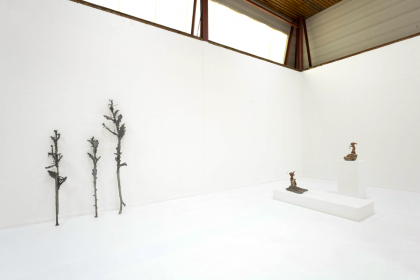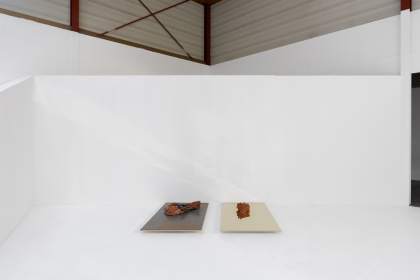
Art as a private exercise in a distant echo of sparkling post-war sculpture (*)
Caroline Coolen’s artistic production is the emanation of hard-won, bare-handed research and an ‘animalist’ inspired quest for a visual language that, independent of contemporary art world trends, strives to fathom the state of affairs within our conflicted human existence. Coolen works in a rural context; an environment that is increasingly considered to be ‘strange and alienating’ within contemporary modernity and ‘distanced’ from the more appreciated image of man that is created by nature. Man has lost the organic link with nature; nature is artificially camouflaged in cultural-tourist packages such as parks, managed forests with perfectly maintained footpaths ... and in processed food, the origin of which is almost impossible to trace.
Caroline Coolen works on a diverse oeuvre in a place where nature – ‘the great outdoors’ – still breathes in her skin. Her studio is not an orderly one with empty tables, multiple PCs and numerous assistants. In near permanent living and working arrangements, she is occupied with a contrary two- and three-dimensional visual language that is characterised by simple motifs and permeated by an intimate symbiosis with the elusive state of being between man, animal and universe. Her artistic work does not seek out slippery beauty; it takes shape and form through the conversion/duplication of recycled materials which, not infrequently, are used in the renovation and construction world. The appropriation of dilapidated, worn-out and economically worthless materials and objects means that these ‘raw materials’ are already imbued with a long and intense life; a life that often shows signs of erosion by time and weather, which means their artistic addition remains linked to the essentially insignificant history of that material.
Caroline Coolen surrounds herself with piles of usable rubbish and seeks out the anomalies of decay in the folds between nature and culture. She is an archaeologist who converts her findings into images that stretch beyond time. Like an archaeologist with a keen eye for the banal, she makes ‘imprints’ on (and of) the weather-beaten and neglected tracks of the former military airport/airbase Brustem/Sint-Truiden. When she accidentally found the skeleton of a dog under the floorboards of her home during renovation work, she transformed the remains into the sculpture Black Dog, which is made of black and purple glass. Through the things she finds ‘remarkable’, she produces art in which time and meaning present themselves as diaphanous and ‘glassily’ mysterious.
Weeds such as thistles eventually overrun all that man neatly ‘superimposes’ on nature; uninvited thistles with lofty and untouchable spines will quickly triumph – in the blink of an eye – over the tarmacked runways of the military airport, a place that was once simultaneously charged with defending the home territory and usurping a non-indigenous one. A series of man-sized thistles cast in bronze lean against a wall of her studio, like soldiers. The thistles are the symbol of anti-nature, of malodourous and intolerable weeds that must (and will) be eradicated. In short, thistles are anti-purity; disruptors of our idyllic view of what we understand by the rubric of ideal nature.
The visually raw-looking thistles are now ‘transplanted’ to the contemporary art context, ‘signs’ that incorporate a visible and abject reference to the idealised concept of austerity and uncontaminated beauty. Thistles here become both the focus and subject of a dialectical discussion. On the one hand, through an artificial representation, the thistle is placed centrally within an artistic context that celebrates the separation between art and reality, and at the same time, weeds that ideally ought to be eradicated are given an artistic form that emphasises their organic beauty. The Thistles series simultaneously becomes an ‘image-propagating’ echo in another artwork, one that is ‘printed’ onto a galvanised metal plate to which a pixelated thistle motif is applied. Here, the motif is ripped from its familiar pictorial context and becomes a sort of logo for something related to an image of the future. The pixelated thistle is an abstraction of a natural thing that only minimally sheds its layers in a computer manipulated geo-drawing. Here, Caroline Coolen plays a skilful high-stakes game with nature and culture by aesthetically converting an artwork into a logo, as a related representation that completely obviates, in concrete terms, the relationship with the prickly original.
(Meanwhile, a slender and lithe dog trots in and around her studio and home, a touch nervously, as well as up and down the stairs leading to her live-work space).
On the wall hangs a series of light brown synthetic resin casts with the smooth shapes of (skinned) dogs; it suggests that Caroline Coolen loves the absurd oeuvre of the American artist Bruce Nauman, which cuts through the marrow and soul. About one of his famous carousels, the eminent artist posited: “From the beginning I was trying to see if I could make work that was just there all at once. Like getting hit in the face with a baseball bat. Or better, like getting hit in the back of the neck. You never see it coming; it just knocks you down”. The same impression sometimes strikes the viewer who looks – eye to eye – at the work of Caroline Coolen, an artist who is patently oblivious to the hyped representations of the ‘contemporary’ world that speed by. Her work confronts the visitor with images that glide past the gleaming interests of contemporary, instantly politically-correct art, for example. And that can be seen as an act of gentle resistance against the cultural primacy of the rapidly evolving actuality, both in the world at large and in art.
The work Black Swan flows from the same sculptural desire to turn existing objects that have been ‘written off’ – such as those jet-black, worn-out car tyres that not infrequently end up with farmers who use them to pin down the black tarpaulins over their manure heaps in stormy weather) – into her vision, a strip of tyre cast in bronze, a graceful twist in the form of an enticingly primary reference to a swan. The concrete lumpiness of a car tyre versus its stylised bronze derivative in the form of a swan!
Caroline Coolen casts a spell on the enormous stash of natural and consumer detritus and breathes new formal life into it in one way or another, the origin of that recycled material charging her artworks with an invariably dual significance. Her oeuvre is permeated with a mix of object familiarity, ‘dépaysement’ [displacement] of situations and circumstances, and the integration of a strong notion of time in matter.
Polilla is a series in which a familiar printed motif, almost stripped of all content, once again settles on galvanised sheets that have been recovered from the construction site. The motif of a night butterfly – a moth – remains as a rare symbiosis between a support weathered by time and the method of applying the motif. The moth sits within; this is also sometimes noticeable in the vast swathes of ‘anything goes’ contemporary artistic production, whereby the recent lack of discourse gives free reign to the capricious fashions and tendencies.
The moth as a symmetrical motif clings to the rickety metal plates and indirectly signals the duality between day and night; between that which is visible and that which hovers in the twilight. Caroline Coolen does not hide her interest in the folk art of the former Eastern Bloc country of Romania. In one of the Polilla plates, the cut-out shapes in the metal are derived from the cheerful, decorative wood carvings on the facades of rural Romanian houses. It is also the birthplace of the master sculptor Constantin Brancusi.
Art remains a mental thing, as does the solitary making of it. Sketching on paper is often the ‘thought’ process that precedes the creation in concreto. The Bozzetti series can be seen as Caroline Coolen’s practice in clay, complemented by the assemblage of fragments of popular and sometimes antique devotional porcelain. Sketching transforms the doubt into conceptual images, into ‘models’ that convert the conceptual visual thinking into material form. Caroline Coolen’s Bozzetti works occasionally seem like maquettes that are not only hungering for more monumental proportions but also possess a subcutaneous desire for a presence in the public space.
Caroline Coolen’s oeuvre is a feast for the eyes; a feast with a sting in the tail because her work plays a contradictory role in today’s accelerated consumption of art. The conflict of (and with) the contemporaneity of art plays itself out in Coolen’s production as in a positive wrenching movement of trial and error.
The monumentally layered print Fest is a perfect example of this; by means of woodcut and monotype, she succeeds in creating a synthesis whereby her motifs are depicted interchangeably and the decoratively jagged motifs continue to reverberate like barbs in our all too routine and value-free way of looking at art.
Luk Lambrecht
April 2021
(*)
The title of this text can also signify its conclusion. Caroline Coolen’s art ‘internalises’ numerous characteristics of international (sculpture) art from, say, Auguste Rodin onwards. Her oeuvre dances on the sinuous relief of the narrative and discourse in modern sculpture; that is ‘fodder’ for possibly another, broader reflection.









